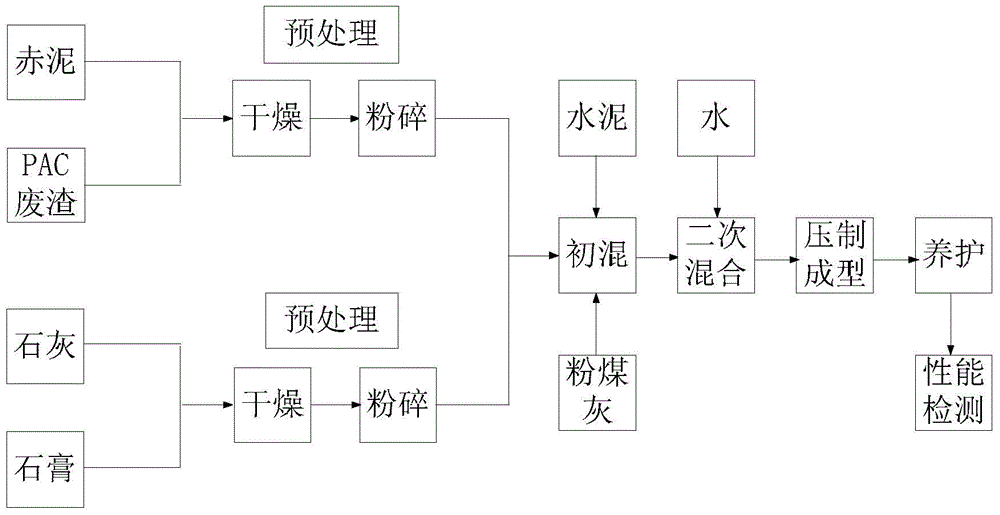Braking-free brick mainly prepared from polyaluminum chloride waste residues and red mud and preparation method thereof
A technology of polyaluminum chloride and unburned bricks, which is applied in the direction of solid waste management, sustainable waste treatment, climate sustainability, etc., can solve the problems of low cost, achieve low cost, improve compressive strength, and good technical performance Effect
- Summary
- Abstract
- Description
- Claims
- Application Information
AI Technical Summary
Problems solved by technology
Method used
Image
Examples
Embodiment 1
[0037]1. Dry red mud and PAC waste residue at 105°C for 3 hours respectively. After natural cooling, crush the dried red mud and pass through a 80-mesh sieve to obtain red mud powder. Grind the dried PAC waste residue and pass through 40 Mesh sieve to get PAC waste residue powder.
[0038] 2. Dry the lime and gypsum respectively at 105°C for 3 hours. After natural cooling, crush the dried lime and gypsum respectively, and pass through a 100-mesh sieve to obtain lime powder and gypsum powder respectively.
[0039] 3. Weigh 25 parts of red mud powder, 45 parts of polyaluminum chloride waste slag powder, 20 parts of fly ash, 6 parts of lime, and 4 parts of gypsum. Stir and mix the above raw materials evenly for initial mixing. The initial mixing time is 3 minutes , and then add 8 parts of water, and then carry out secondary mixing by stirring, and the mixing time of secondary mixing is 5min to obtain a mixture. The added water can be tap water, recovered reclaimed water or conde...
Embodiment 2
[0044] 1. Dry red mud and PAC waste residue at 105°C for 4 hours respectively. After natural cooling, crush the dried red mud and pass through a 80-mesh sieve to obtain red mud powder. Grind the dried PAC waste residue and pass through 40 Mesh sieve to get PAC waste residue powder.
[0045] 2. Dry lime and gypsum respectively at 105°C for 4 hours, and after natural cooling, crush the dried lime and gypsum respectively, and pass through a 100-mesh sieve to obtain lime powder and gypsum powder respectively.
[0046] 3. Weigh 35 parts of red mud powder, 35 parts of polyaluminum chloride waste residue powder, 2 parts of cement, 18 parts of fly ash, 5 parts of lime, and 5 parts of gypsum. Stir the above raw materials evenly for initial mixing. The time is 4 minutes, then 10 parts of water are added, and then the secondary mixing is carried out by stirring, and the mixing time of the secondary mixing is 4 minutes to obtain a mixture. The added water can be tap water, recovered recl...
Embodiment 3
[0051] 1. Dry red mud and PAC waste residue at 105°C for 3 hours respectively. After natural cooling, crush the dried red mud and pass through a 80-mesh sieve to obtain red mud powder. Grind the dried PAC waste residue and pass through 40 Mesh sieve to get PAC waste residue powder.
[0052] 2. Dry the lime and gypsum respectively at 105°C for 3 hours. After natural cooling, crush the dried lime and gypsum respectively, and pass through a 100-mesh sieve to obtain lime powder and gypsum powder respectively.
[0053] 3. Weigh 35 parts of red mud powder, 35 parts of polyaluminum chloride waste residue powder, 5 parts of cement, 15 parts of fly ash, 4 parts of lime, and 6 parts of gypsum. Stir the above raw materials evenly for initial mixing. The time is 5 minutes, then 12 parts of water are added, and the second mixing is carried out by stirring, and the mixing time of the second mixing is 5 minutes to obtain a mixture. The added water can be tap water, recovered reclaimed water...
PUM
| Property | Measurement | Unit |
|---|---|---|
| Compressive strength | aaaaa | aaaaa |
| Compressive strength | aaaaa | aaaaa |
| Flexural strength | aaaaa | aaaaa |
Abstract
Description
Claims
Application Information
 Login to View More
Login to View More - R&D
- Intellectual Property
- Life Sciences
- Materials
- Tech Scout
- Unparalleled Data Quality
- Higher Quality Content
- 60% Fewer Hallucinations
Browse by: Latest US Patents, China's latest patents, Technical Efficacy Thesaurus, Application Domain, Technology Topic, Popular Technical Reports.
© 2025 PatSnap. All rights reserved.Legal|Privacy policy|Modern Slavery Act Transparency Statement|Sitemap|About US| Contact US: help@patsnap.com

